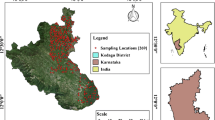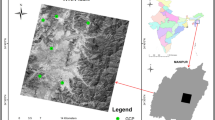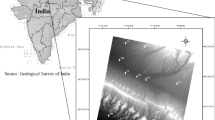Abstract
Declassified CORONA images provide stereo pairs that could be used for preparation of Digital Elevation Models (DEMs) and orthophotos that could be an invaluable resource in accounting historical information. In the present work, KH-9 Hexagon CORONA images of Bilaspur district, Himachal Pradesh, India are used for the generation of DEM and orthophoto using photogrammetric techniques and tools. ASTER DEM and TanDEM-X were used to validate the generated CORONA DEM. The CORONA DEM elevation profiles at three different locations were compared with ASTER DEM and TanDEM-X. These profiles match very closely with each other. The change percentage of elevation is within 1%, between CORONA DEM and ASTER DEM, and TanDEM-X when computed for random 100 points. However, the elevation at the Bhakra dam has submeter level variation when measured using CORONA DEM. According to published reports, the elevation of the Bhakra dam is 487.68 m, while that is estimated to be 487.88 m in CORONA DEM. Furthermore, Landsat-3 MSS (1979) data is used to validate the orthophoto generated from the stereo pairs. The Govind Sagar reservoir in the study area is demarcated using object-based classification and it showed a difference of 75.91 ha between CORONA orthophoto and Landsat-3 satellite images for 1979. The water bodies are extracted in the study area between 1979 and 2010 using the object-based image classification technique. The area of the water reservoir is decreased by − 7.70%, − 4.57%, and − 19.50% between 1979 and 1990, 1990 and 2000, and 2000 and 2010. We found that annual rainfall is decreasing with an increase in temperature which could be the reason for declining reservoir area. This decrease in reservoir area could also be attributed to depleting water resources, enhanced water extraction, and increased sedimentation near the reservoir. The DEM prepared using the CORONA images can be used for the representation of the earlier earth’s surface and can be used as a reference for change detection and deformation studies.








Similar content being viewed by others
Data availability
The data used in this work is freely downloadable from various sources as mentioned in the text and the acknowledgment.
References
Agapiou A (2021) Land cover map** from colorized CORONA archived greyscale satellite data and feature extraction classification. Land 10(8):771
Al-Rousan N, Cheng P, Petrie G, Toutin T, Zoej MV (1997) Automated DEM extraction and orthoimage generation from SPOT level 1B image. Photogramm Eng Remote Sens 63(8):965–974
Altmaier A, Kany C (2002) Digital surface model generation from CORONA satellite images. ISPRS J Photogramm Remote Sens 56(4):221–235. https://doi.org/10.1016/S0924-2716(02)00046-1
Asra, G (1989). Theory and applications of optical remote sensing.
Andersen GL (2006) How to detect desert trees using CORONA images: Discovering historical ecological data. J Arid Environ 65(3):491–511
Bhakra Project, 1948. Developmental History of Bhakra-Nangal Dam Project, https://bbmb.gov.in/bhakra-project.htm (Accessed 14 December 2019)
Bolch T, Buchroithner M, Pieczonka T, Kunert A (2008) Planimetric and volumetric glacier changes in the Khumbu Himal, Nepal, since 1962 using CORONA, Landsat TM and ASTER data. J Glaciol 54(187):592–600
Casana J, Cothren J (2008) Stereo analysis, DEM extraction and orthorectification of CORONA satellite image: archaeological applications from the Near East. Antiquity 82(317):732–749. https://doi.org/10.1017/S0003598X00097349
Casana, J., & Cothren, J. (2013). The CORONA Atlas Project: orthorectification of CORONA satellite image and regional-scale archaeological exploration in the Near East. In Map** archaeological landscapes from space (pp. 33–43). Springer, New York, NY.
CGWB (Central Ground Water Board) (2013) Ground water information booklet, Bilaspur district, Himachal Pradesh. http://cgwb.gov.in/District_Profile/HP/ Bilaspur.pdf. Accessed 15 June 2021
Chavez PS (1996) Image-based atmospheric corrections-revisited and improved. Photogramm Eng Remote Sens 62(9):1025–1035
Chen, C. F., Chang, L. Y., & Yang, S. R. (2012). U.S. Patent No. 8,184,144. Washington, DC: U.S. Patent and Trademark Office.
Fekete A (2020) CORONA high-resolution satellite and aerial imagery for change detection assessment of natural hazard risk and urban growth in El Alto/La Paz in Bolivia, Santiago de Chile, Yungay in Peru, Qazvin in Iran, and Mount St. Helens in the USA Remote Sensing 12(19):3246
Galiatsatos N, Donoghue DN, Philip G (2007) High resolution elevation data derived from stereoscopic CORONA image with minimal ground control. Photogramm Eng Remote Sens 73(9):1093–1106
Gheyle W, Trommelmans R, Bourgeois J, Goossens R, Bourgeois I, De Wulf A, Willems T (2004) Evaluating CORONA: a case study in the Altai Republic (South Siberia). Antiquity 78(300):391–403
Ghuffar, S, Bolch, T, Rupnik, E, and Bhattacharya A (2022). A pipeline for automated processing of CORONA KH-4 (1962–1972) stereo imagery. ar**v preprint ar**v:2201.07756.
Gupta S, K. and Shukla D P (2017). Utilization of TanDEM-X-X Dem for topographic correction of Sentinel-2 Satellite image. Pecora.
Gupta SK, Shukla DP (2020) Evaluation of topographic correction methods for LULC preparation based on multi-source DEMs and Landsat-8 imagery. Spat Inf Res 28(1):113–127
Horn BK (1981) Hill shading and the reflectance map. Proc IEEE 69(1):14–47
Hu Y, Tao V, and Croitoru A (2004). Understanding the rational function model: methods and applications. International archives of photogrammetry and remote sensing 20(6)
Jacobsen K (2001) Exterior orientation parameters. Photogramm Eng Remote Sens 67:12–47
Jensen, J.R (1996). Introductory digital image processing: a remote sensing perspective (No. Ed. 2). Prentice-Hall Inc.
Lamsal D, Sawagaki T, Watanabe T (2011) Digital terrain modelling using CORONA and ALOS PRISM data to investigate the distal part of Imja Glacier, Khumbu Himal. Nepal Journal of Mountain Science 8(3):390–402
Liu J, Wang L, Teng F, Li D, Wang X, Cao H (2015) Crop area ground sample survey using Google Earth image-aided. Transactions of the Chinese Society of Agricultural Engineering 31(24):149–154
McDonald RA (1995) Opening the Cold War sky to the public: declassifying satellite reconnaissance image. Photogramm Eng Remote Sens 61(4):385–390
Mészáros M, Szatmari J, Tobal Z, Mucsi L (2008) Extraction of digital surface models from CORONA satellite stereo images. Journal of Environmental Geography 1(1–2):5–10
Mihai B, Nistor C, Toma L, Săvulescu I (2016) High resolution landscape change analysis with CORONA KH-4B imagery. A case study from Iron Gates reservoir area. Procedia Environ Sci 32:200–210
Philip G, Donoghue DNM, Beck AR, Galiatsatos N (2002) CORONA satellite photography: an archaeological application from the Middle East. Antiquity 76(291):109–118
Pieczonka T, Bolch T, Junfeng W, Shiyin L (2013) Heterogeneous mass loss of glaciers in the Aksu-Tarim Catchment (Central Tien Shan) revealed by 1976 KH-9 Hexagon and 2009 SPOT-5 stereo image. Remote Sens Environ 130:233–244
Pinto AT, Gonçalves JA, Beja P, Pradinho Honrado J (2019) From archived historical aerial image to informative orthophotos: a framework for retrieving the past in long-term socioecological research. Remote Sensing 11(11):1388
Price JC (1987) Calibration of satellite radiometers and the comparison of vegetation indices. Remote Sens Environ 21(1):15–27
Richards J A (1993). Sources and characteristics of remote sensing image data. In Remote sensing digital image analysis (pp. 1–37). Springer, Berlin, Heidelberg
Ruffner KC (ed) (1995) CORONA: America’s first satellite program. History Staff, Center for the Study of Intelligence, Central Intelligence Agency
Schmidt S, and Nüsser M (2009). Glacier changes in the Nanga Parbat Himalayas: a re-photographic survey between the 1930s and now. In EGU General Assembly Conference Abstracts (Vol. 11 p. 5801)
Schmidt M Goossens R, Menz G, Altmaier A and Devriendt D (2001a). The use of CORONA satellite images for generating a high resolution digital elevation model. In IGARSS 2001a. Scanning the Present and Resolving the Future. Proceedings. IEEE 2001a International Geoscience and Remote Sensing Symposium (Cat. No. 01CH37217) (Vol. 7, pp. 3123-3125). IEEE.
Schmidt M, Goossens R, Menz G (2001b) Processing techniques for CORONA satellite images in order to generate high-resolution digital elevation models (DEM). Observing Our Environment from Space: New Solutions for a New Millennium, 191–196
Sohn HG, Kim GH, Yun KH (2002) Rigorous sensor modeling of early reconnaissance CORONA image for monitoring urban growth. In IEEE International Geoscience and Remote Sensing Symposium. 3:1929–1931 (IEEE)
Sohn HG, Kim GH, Yom JH (2004) Mathematical modelling of historical reconnaissance CORONA KH-4B Image. Photogram Rec 19(105):51–66
Song DX, Huang C, Sexton JO, Channan S, Feng M, Townshend JR (2015) Use of Landsat and CORONA data for map** forest cover change from the mid-1960s to 2000s: Case studies from the Eastern United States and Central Brazil. ISPRS J Photogramm Remote Sens 103:81–92
Stratoulias D and Kabaday M E (2020). Feature and information extraction for regions of Southeast Europe from CORONA satellite images acquired in 1968. In Eighth International Conference on Remote Sensing and Geoinformation of the Environment (RSCy2020) (Vol. 11524, p. 115241R). International Society for Optics and Photonics
Stratoulias D, Grekousis G (2021) Information Extraction and Population Estimates of Settlements from Historic CORONA Satellite Image in the 1960s. Sensors 21(7):2423
Surazakov A, Aizen V (2010) Positional accuracy evaluation of declassified Hexagon KH-9 map** camera image. Photogramm Eng Remote Sens 76(5):603–608
Tanathong S, Lee IP (2010) Speeding up the KLT tracker for real-time image georeferencing using GPS/INS data. Korean Journal of Remote Sensing 26(6):629–644
Teillet PM, Guindon B, Goodenough DG (1982) On the slope-aspect correction of multispectral scanner data. Can J Remote Sens 8(2):84–106
Thompson JA, Bell JC, Butler CA (2001) Digital elevation model resolution: effects on terrain attribute calculation and quantitative soil-landscape modelling. Geoderma 100(1–2):67–89
Toutin T (2000). Evaluation of radargrammetric DEM from RADARSAT images in high relief areas. IEEE Transactions on Geoscience and Remote Sensing. 38(2):782–789
Watanabe N, Nakamura S, Liu B, Wang N (2017) Utilization of Structure from Motion for processing CORONA satellite images: application to map** and interpretation of archaeological features in Liangzhu Culture, China. Archaeological Research in Asia 11:38–50
Acknowledgements
The authors would like to express their gratitude to IIT Mandi in Kamand, Himachal Pradesh, India, for giving this forum and technical tools to perform this study. We would also like to thank the USGS, the Land Processes Distributed Active Archive Centre (LP DAAC), and the TerraSAR-X Science Service System for allowing us to use the Landsat, SRTM, ASTER DEM, ERA 5 and TERRA climate, and TanDEM-X datasets in this work. TanDEM-X data was made available to DPS under the DEM project no DEM_GEOL0926 funded by DLR, Germany. The authors are thankful for the comments provided by the anonymous reviewers that have shaped the manuscript in a better representable form.
Author information
Authors and Affiliations
Corresponding author
Ethics declarations
Conflict of interest
The authors declare no competing interests.
Additional information
Publisher's Note
Springer Nature remains neutral with regard to jurisdictional claims in published maps and institutional affiliations.
Springer Nature or its licensor holds exclusive rights to this article under a publishing agreement with the author(s) or other rightsholder(s); author self-archiving of the accepted manuscript version of this article is solely governed by the terms of such publishing agreement and applicable law.
Supplementary Information
Below is the link to the electronic supplementary material.
Rights and permissions
Springer Nature or its licensor holds exclusive rights to this article under a publishing agreement with the author(s) or other rightsholder(s); author self-archiving of the accepted manuscript version of this article is solely governed by the terms of such publishing agreement and applicable law.
About this article
Cite this article
KC, N., Thapa, L. & Shukla, D.P. Processing CORONA image for generation of Digital Elevation Model (DEM) and orthophoto of Bilaspur district, Himachal Pradesh. Appl Geomat 15, 295–310 (2023). https://doi.org/10.1007/s12518-022-00453-z
Received:
Accepted:
Published:
Issue Date:
DOI: https://doi.org/10.1007/s12518-022-00453-z




